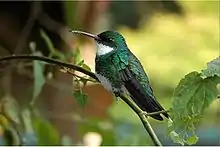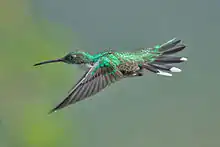White-throated hummingbird
The white-throated hummingbird (Leucochloris albicollis) is a species of hummingbird in the family Trochilidae. It is the only member of the genus Leucochloris. It is found in north-eastern Argentina, south-eastern Brazil, Paraguay, and Uruguay. It is found in forest, woodland, parks and gardens. It is generally common, and therefore considered to be of least concern by BirdLife International.
| White-throated hummingbird | |
|---|---|
 | |
| Scientific classification | |
| Kingdom: | Animalia |
| Phylum: | Chordata |
| Class: | Aves |
| Order: | Apodiformes |
| Family: | Trochilidae |
| Tribe: | Trochilini |
| Genus: | Leucochloris Reichenbach, 1854 |
| Species: | L. albicollis |
| Binomial name | |
| Leucochloris albicollis (Vieillot, 1818) | |
French ornithologist Louis Jean Pierre Vieillot described the white-throated hummingbird in 1818 as Trochilus albicollis. Its species name is derived from the Latin words albus "white" and collum "neck".[2] Ludwig Reichenbach erected the genus Leucochloris in 1854, deriving the name from the Ancient Greek leukos "white" and chloros "green".
A 2014 genetic study found that it lay within the large genus Amazilia, and that it diverged around 5 million years ago from a lineage that gave rise to the green-and-white hummingbird (Amazilia viridicauda), white-bellied hummingbird (A. chionogaster), rufous-throated sapphire (A. sapphirina), gilded sapphire (Hylocharis chrysura), sapphire-spangled emerald (A. lactea), and glittering-throated emerald (A. fimbriata).[3]

The white-throated hummingbird is 10–11·5 cm (4-4.5 in) long,[4] with a distinctive white throat, belly and tail tips.[5] The head, upperparts, wing coverts, chin and sides of neck are an iridescent green. The rest of the wings are purple-brown.[6] It is unlikely to be confused with any other bird species.[5] The male weighs 5–8 g (0.17–0.28 oz), while the female weighs around 4·5 g (0.16 oz).[4]
The white-throated hummingbird is found in forest margins, marshy areas, shrubland and parks.[4] It forages at both terrestrial and arboreal bromeliads such as Quesnelia testudo and Tillandsia aeranthos, as well as Mendoncia velloziana,[7] and Siphocampylus sulfureus.[8]
References
- BirdLife International (2012). "Leucochloris albicollis". IUCN Red List of Threatened Species. 2012. Retrieved 26 November 2013.CS1 maint: ref=harv (link)
- Simpson, D.P. (1979). Cassell's Latin Dictionary (5th ed.). London: Cassell Ltd. pp. 33, 116. ISBN 0-304-52257-0.
- McGuire, Jimmy A; Witt, Christopher C; Remsen, J V; Corl, Ammon; Rabosky, Daniel L; Altshuler, Douglas L; Dudley, Robert (2014). "Molecular phylogenetics and the diversification of hummingbirds". Current Biology. 24 (8): 910–16. doi:10.1016/j.cub.2014.03.016. PMID 24704078.
- Weller, A.A., Kirwan, G.M. & Boesman, P. (2017). White-throated Hummingbird (Leucochloris albicollis). In: del Hoyo, J., Elliott, A., Sargatal, J., Christie, D.A. & de Juana, E. (eds.). Handbook of the Birds of the World Alive. Lynx Edicions, Barcelona. (retrieved from http://www.hbw.com/node/55474 on 19 September 2017).
- van Perlo, Ber (2009). A Field Guide to the Birds of Brazil. Oxford University Press. ISBN 9780199745654.
- Hudson, William Henry (5 December 2016). Argentine Ornithology: A Descriptive Catalogue of the Birds of the Argentine Republic, Volume II. Library of Alexandria. p. 23. ISBN 978-1-4655-4745-3.
- Snow, David W.; Teixeira, Dante L. (1982). "Hummingbirds and their flowers in the coastal mountains of southeastern Brazil". Journal für Ornithologie. 123 (4): 446–50. doi:10.1007/BF01643279. S2CID 23568595.
- Sazima, Marlies; Sazima, Ivan; Buzato, Silvana (1994). "Nectar by day and night: Siphocampylus sulfureus (Lobeliaceae) pollinated by hummingbirds and bats". Plant Systematics and Evolution. 191 (3): 237–46. doi:10.1007/bf00984668. S2CID 262033.
